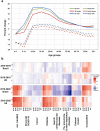This is a preprint.
COVID-19 is not an Independent Cause of Death
- PMID: 35677081
- PMCID: PMC9176661
- DOI: 10.1101/2022.06.01.22275878
COVID-19 is not an Independent Cause of Death
Update in
-
Research Note: COVID-19 Is Not an Independent Cause of Death.Demography. 2023 Apr 1;60(2):343-349. doi: 10.1215/00703370-10575276. Demography. 2023. PMID: 36794776
Abstract
The COVID-19 pandemic has had overwhelming global impacts with deleterious social, economic, and health consequences. To assess the COVID-19 death toll researchers have estimated declines in 2020 life expectancy at birth. Because data are often available only for COVID-19 deaths, the risks of dying from COVID-19 are assumed to be independent of those from other causes. We explore the soundness of this assumption based on data from the US and Brazil, the countries with the largest number of reported COVID-19 deaths. We use three methods. One estimates the difference between 2019 and 2020 life tables and therefore does not require the assumption of independence. The other two assume independence to simulate scenarios in which COVID-19 mortality is added to 2019 death rates or is eliminated from 2020 rates. Our results reveal that COVID-19 is not independent of other causes of death. The assumption of independence can lead to either an overestimate (Brazil) or an underestimate (US) of the decline in e 0 , depending on how the number of other reported causes of death changed in 2020.
Figures

References
-
- Arias E., Betzaida T.-V., Ahmad F., and Kochanek K.. 2021. “Provisional Life Expectancy Estimates for 2020.” National Center for Health Statistics (U.S.) 10.15620/cdc:107201. September 14, 2021. - DOI
-
- Centers for Disease Control and Preventionand National Center for Health Statistics. 2021. “Underlying cause of death 2018–2020 on CDC WONDER Online Database, released in 2021. Data are from the multiple cause of death files, 2018–2020. Accessed at http://wonder.cdc.gov/ucd-icd10-expanded.html.”
Publication types
Grants and funding
LinkOut - more resources
Full Text Sources
